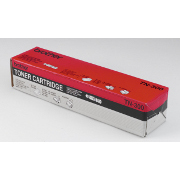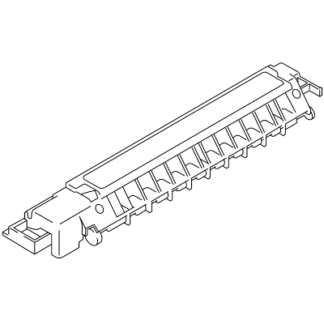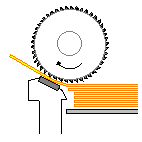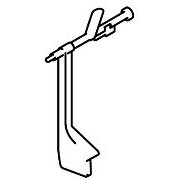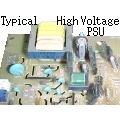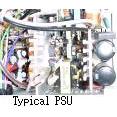Brother Original Toners
Fuser
Spares
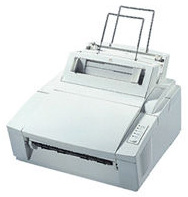
Brother HL-1060 / HL-1070
A series of A4 laser printers launched in 1998. These printers have the paper feed at the top rear, as with the HL-720 and HL-820. What is different here is that these printers have two multipurpose trays at the rear and paper emerges through the front.
They might be considered rather old and slow by today's standards but are still suited to small office use whilst parts are available.
These printers are very like the HL-1020 HL-1040 and take same consumables, they do have different fusers and scanners and the extra trays make a difference to the drive chain.
As with most Brother printers these machines use a separate toner and drum (The TR-300 and DR-300, more information below).
The HL-1070 is an improved HL-1060, it has USB support and Brother's BR-Script2 Postscript emulation with 4MB of memory and a more powerful processor.
Control:
1 switch and 5 lamps
A utility program called Remote Printer Console (RPC) was originally shipped with these printers (The HL-1040 and HL1050). RPC runs in DOS mode and changes the default settings of the printer such as fonts, page setup and emulations.
Printing the test pages
Turn on the power switch whilst pressing the control panel switch, this enters inspection mode. At first "drum" lights. Holding down the switch will cause Drum, Alarm, Ready, Data, and then Drum again to light. When the switch is released the mode is selected.
Drum - Factory inspection mode - for details see the service manual
Alarm - Continuous grid pattern print mode
Ready - 3 patterns print mode (grid, zip, black)
Data - NV-RAM value dump mode
Drum + Alarm - ROM code reprogramming mode (only when the flash memory is fitted)
Alarm + Ready - RAM check
Ready + Data - 4% density pattern print mode
For an explanation of the modes see the Service Manual.
Duty Cycle:
We don't have any duty cycle figures or MTBF for these printers. They were lightly built.
Print Speed:
The HL-1060 and HL-1070 have a maximum print speed of 10 pages per minute, as for the HL-1020, HL-1040 and HL-1050. The service manual says this is when loading Letter-size paper from the multipurpose sheet feeders.
First Print in 15 seconds from standby.
Warm up in 30 seconds at 23°C (73.4°F) The warm up time depends on the ambient temperature and humidity
Scanner Abilities:
This printer series also appeared as the MFC-P2000 but there are differences such as the fuser part number.
Print Resolution:
True resolution of up to 1200 (H) x 600 (V) dots/inch for Windows DIB graphics
600 x 600 dots/inch for Windows and DOS
300 x 300 dots/inch under Apple Macintosh using the optional RS-100M
Best print quality can be sacrificed for economy using the Economy printing mode giving up to 25% and 50% toner savings
Paper Handling:
The printer is unusual in having two feeders at the rear.
Paper travels a nearly straight path when the front catcher tray is open.
Tray 1:
Multi-purpose sheet feeder that also allows maunual paper loading for labels andtransparencies.
Paper type for Sheet Feeder 1 (Front): Normal paper weights 60 to 157gsm, specified types of high-quality paper
- A4 size
- Letter size
- Legal size
- B5 (JIS ISO) size
- A5 size
- A6 size
- Executive size
- 9" envelop size (maximum printable area)
The recommended types of plain paper are as follows:
Letter : Xerox 4200 (75g/m2)
A4 : Xerox 80 Premier Paper (80g/m2)
Tray 2:
Paper type for Sheet Feeder 2 (Rear ) Normal paper weights 60 to 157gsm, specified types of high-quality paper
- A4 size
- Letter size
- Legal size
- B5 (JIS ISO) size
- Executive size
Face Down:
With the output tray opened
Tray capacity: Maximum 100 sheets (80g/m2), face-down only
With the output tray closed
Tray capacity: 1 sheet (80g/m2), face-down only
Duplex:
Manual duplexing only. Be sure to straighten the paper as much as possible before feeding it through the machine a second time.
Processor:
These members of the Brother HL series use different processors.
HL-1060 - IDT 79R3041-20J 20mhz
HL-1070 - Fujitsu MB86831 66Mhz
Memory:
HL-1060: 2.0 Mbytes. Expandable up to 34 Mbytes by installing one industry standard SIMM
HL-1070: 4.0 Mbytes Expandable up to 36 Mbytes by installing one industry standard SIMM
Data compression in the hardware and driver software allow the printer to handle most full-page 600 dpi graphic and text data with standard memory.
Interface:
Bi-directional parallel
USB Interface on the HL-1070 only
Optional Apple Macintosh Interface for the HL-1040/1050. This optional interface board can be used as an RS-422A interface for Macintosh or an RS-232C serial interface for an IBM PC or compatible.
Network:
Some external print servers support printers in this series. Note that the Printer Status Monitor Progrm waon't work with printers on a network.
Network Protocols:
The printer doesn't support networking itself.
Print Languages:
One of the distinctions between the HL-1060 and HL-1070 is a slightly different set of language support including the BR-Script Level 2 PostScript emulation.
HL-1060: Brother Printing Solution for Windows (GDI Printers but not using WPS)
Automatic emulation selection among HP LaserJet 5P, EPSON, FX-850 or IBM Proprinter XL
Printer Driver Windows 3.1/3.11 and Windows 95 driver, supporting Brother Printing Solution for Windows, Brother Native Compression mode and bi-directional capability
HL-1070: Brother Printing Solution for Windows (GDI Printers but not using WPS)
Automatic emulation selection among HP LaserJet 6P, BR- Script Level 2, EPSON FX-850 or IBM Proprinter XL.
Windows 3.1/3.11, Windows 95/98, and Windows NT 4.0 driver, supporting Brother Printing Solution for Windows, Brother Native Compression mode and bi-directional capability.
Linux CUPS has drivers for the HL-1060 and HL-1070, the HL-1070 allows use of the Foomatic Postscript driver.
System-Compatabilty:
Windows 3.1/3.11, Windows 95 and Windows NT 4.0 driver, supporting Brother Native Compression mode and bi-directional capability.
Optional Macintosh driver available for System 6.0.7 or higher (for HL-1040/1050 only)
There are drivers for Linux as above
Power:
Power source U.S.A. and Canada: AC 110 to 120V, 50Hz/60Hz
Europe and Australia: AC 220 to 240V, 50Hz/60Hz
Power Consumption:
These printers have a conventional fuser based on a halogen lamp heater which is a major part of the power consumption. The lamp goes on and off at intervals which depend on how much printing is being done - and so how much paper needs to be heated. Peak power is worked out when the heater lamp is on, but excludes the inrush current.
Power consumption
Printing (peak): 820W or less
Printing (average): 280W or less
Standing by: 60W or less
Sleep:13W or less
Environment:
Economy Printing Mode
Cuts printing costs by saving toner. particularly useful for draft copies and proof-reading where print density isn't critically important. Two economy modes can be selected: 25% toner saving and 50% toner saving, through the Windows printer driver.
Sleep Mode (Power Save Mode)
Sleep mode automatically reduces power consumption when the printer is not in use. The printer consumes less than 13W when in sleep mode.
Low Running Cost
The toner cartridge is separate from the drum unit. Toner cartridges typically need replacing after around 2,400 pages. The argument for separate units is that it is cost effective and eco- friendly.
Dimensions:
Dimensions (W x D x H) 402 (W) x 439 (D) x 274 (H)
(when the output tray is closed and the Multi-purpose sheet feeder is removed.)
Weight:
Weight Approx. 9.6kg (21.2lb.) including the drum unit and toner cartridge
Acoustic Noise:
Printing:49dB A or less
Standing by: 38dB A or less
Consumables:
When toner is low the Alarm and Data/Toner lights blink every 5 seconds. The printer then has about 100 pages of toner remaining so it is suggested users keep a toner in stock. When Alarm and Data/ Toner blink continuously the toner is empty and the the printer will stop.
Remove the drum to install a new cartridge. The cartridge slides into the drum unit and is locked in place by a lever.
Installing the cartridges can release some lose toner so work on a cleanable surface or use disposable tissue to cover the surface.
Use the corona wire cleaner on the underside of the drum after installing a new toner and Brother recommend cleaning the inside of the printer as well.
TR-300 - page yield about 2,400 pages at 5% cover
Life Expectancy: 2,400 pages/cartridge (when printing A4 or letter-size paper at 5% print coverage)
The TN-300 is compatible with the HL-820, HL-1040, HL-1050, HL-1060, HL-1070, HL-P2000, and MFC-P2000.
Drum and Developer
The printer indicates that a new drum is needed by lighting the "drum" lamp.
The drum in a laser printer uses an organic photoconductor to form the image. The drum material is charged to a high voltage with static electricity but then painted with an image by the laser which discahrges the static. The drum then travels round to a "developer" where fine toner powder is attracted by the static charge. Further round another static charge pulls the image off the drum and onto the paper. The drum travels on round past a cleaner blade. The drum can have a long life but exposure to light and oxygen in the air gradually de-natures it as does contact with the developer and the action of the scraper blade.
Brother give the life expectancy as 20,000 pages per drum unit at 20 pages per job or 8,000 pages at 1 page per job.
Drum units are sold separately from the toner cartridge. DR-300 - page yield up to 20,000 pages depending on use pattern
Part-used cartridges should be removed from a drum and used in it's replacement. Use the wiper to clean the corona wire before installing the drum. When the drum is placed in the printer and the lid closed the printer will eject a starter sheet and reset it's life alarm.
In this case Brother don't seem to have used different part names for European and US markets, the names TN-300 and DR-300 are used in both.
These are old printers and drums are quite expensive. Some web sites such as fixya and fixyourownprinter carry information on cleaning and re-using drums. Cleaning drums is a messy and unreliable process but may suit home users with a technical interest. People using printers in the workplace might opt for professionally refurbished drums.
The drums are used in the HL-820, HL-1020, HL-1040, HL-1050, HL-1060, HL-1070 and HL-P2000.
Fuser:
Fuser errors are indicated by the lights giving a "Service Call message". All the lamps flash then the drum light alternately to indicate fuser failure. It is usually worth turning the printer off, waiting a few seconds, then turning on again to see if the error clears. but if it does not the fuser has probably failed.
Laser printer fusers bond the toner to the page using a combination of heat and pressure. The Brother 1020 series have a top roller coated in non-stick material and heated by a halogen lamp. The non-stick qualities of the roller ultimately fail and smudges of print appear where they aren't wanted. The roller can lose parts of its coating entirely creating streaks or prints down the page. The heater can fail as well, the printer will then give an error as above.
UH3164001 110 Volt Fuser / Fixing unit normally used in the US 110/120 V
UH3165001 220/230 Volt Fuser / Fixing Unit normally used in the UK and Europe 230V
Given their age new fusers for these printers may seem expensive. Replacement parts for the hot roller and lamp are still available in March 2010.
UH3306001, Fuser Lamp 110/120V
UH3307001, Halogen Lamp 230V
UH3419001 Hot Fuser Roller
UL6667001 Thermistor Assembly
UH3188001 Cleaner Assembly
UH3178000 H/R Bearing, 2 Used
Note that the P2000 uses a different fuser:
UL8751001 1 Fixing Unit, 230V for the MFC-P2000 and HL-P2000
Whats-In-The-Box:
These printers originally came with a setup ROM, a setup guide and a user manual on the CD. These printers are now only available from brokers and refurbishers and the most they are likely to provide is a power-cord and a refilled cartridge.
Warranty:
These printers are far too old to have manufacturers warranty cover.
Spares:
Some spares are available in March 2010 but given the age of the printer availability might decline.
UL8749001 Input Tray
UH3074001 PickUp Roller
There are several Electronics Assemblies used in the HL-1060. Not all are listed here.
UK3950001 Main PCB Assembly.
UK3439001 Main PCB Assembly PCL5 2M(SP) B48K246-300J
UK4251001 Main PCB Assembly, Europe
UK3440001 Driver PCB Assembly
UK3443001 High Voltage Power Supply Assembly
UK3442001 Low Voltage Power Supply Assembly 230V (SP)
UG4142001 Toner Sensor Pcb
UH3036001 Main Motor
UH3140001 Reg. Sensor Link
UH3141001 Reg. Lever Spring
UH3145000 Paper Solenoid Lever
UH3248001 Paper Stopper
UH3250000 Exit Tray Support Wire
UH3301001 Laser Scanner Unit
Copyright G & J Huskinson & MindMachine Associates Ltd 2013, 2015. Some pictures derived from Brother User and Service guides. These technical pages do not constitute an offer for sale; just our knowledge at the time of writing. See the catalog. Sales pages on this Web site use cookies to store user information. We also use Google Analytics to track site usage patterns.

